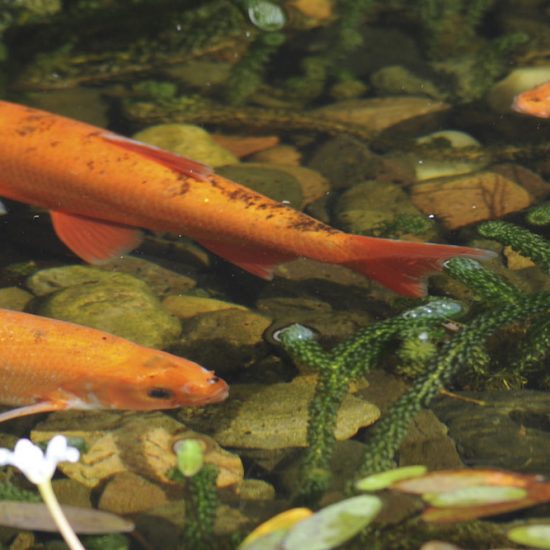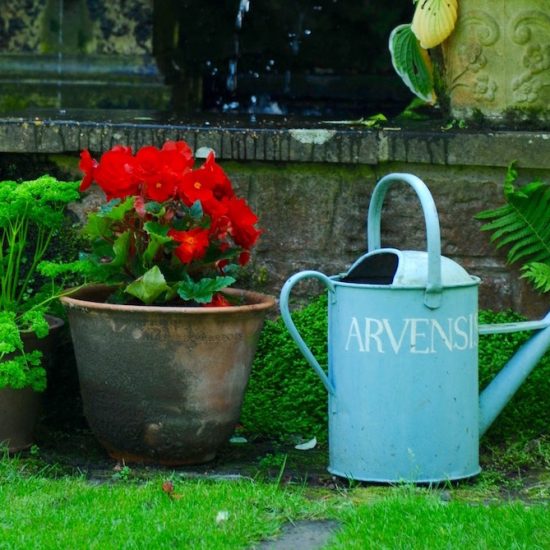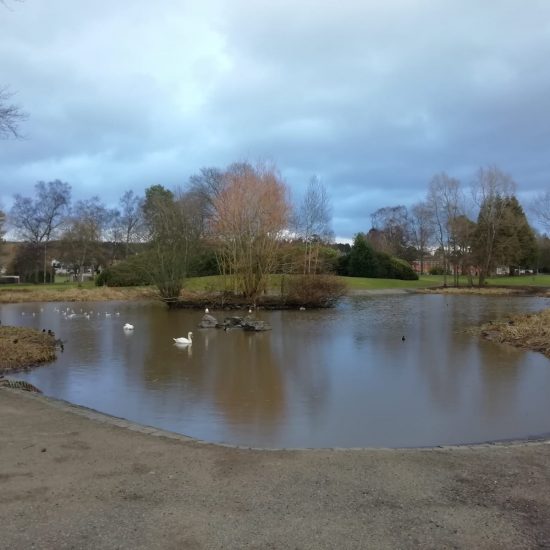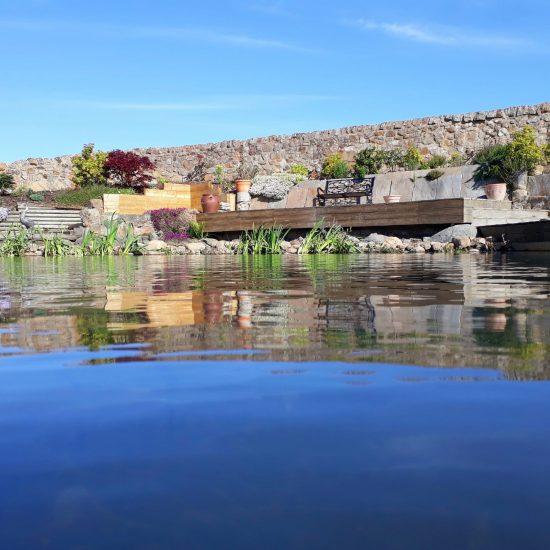
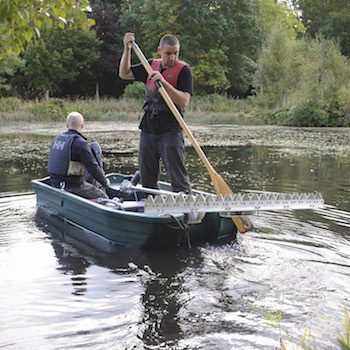
Contact
Stuart Booth
0131 317 8585
Common Problems with Ponds and Frequently Asked Questions
We often get asked for advice about pond maintenance and cleaning, so we have put together some FAQs to help answer some common pond-related issues.
If you can’t find the answer to your issue, please get in touch. We offer a full makeover service, and can also provide further advice to help restore your pond back to its former glory.
1. My pond is leaking – what can I do?
2. Why is my pond water green?
4. Invasive alien species in ponds
My Pond is leaking – what can I do?
There are various steps you can take to diagnose what’s going on:
If you have a pump and a stream or waterfall, and the pond is going down, turn the pump off and the fill the pond up. If you do not get any water loss then, it means that the problem lies elsewhere. The problem is either going to be in the hose from the pump to the top of the water course, or in the water course itself. If it is in the water course, put the pump back on and see if you can locate where the water is actually leaking from. Is it out the sides, over a liner, or through concrete or something like that?
The other thing that can happen is simply debris accumulating in narrow points in the stream or cascade backing the water up behind it and it then flowing out the sides, and you lose water that way.
Assuming you don’t have a water course, or that the leak is not there, then the other obvious problem is a hole in the liner. If you do not fill the pond up, the water level will eventually drop to where the hole is, then you may be able to locate and patch it.
Another potential cause of pond levels dropping, is a liner edge that has become detached from its normal position. This could be caused by something as simple as loose edging, which has allowed the liner to drop down. Water will then run out over this new low point and you end up with what looks like a leak. If you can locate where the problem lies, try pulling the liner back up. Back to FAQs
Why is my pond water green?
The most common cause of green water is lots of light, lots of nutrients and maybe a big silt layer on the bottom of the pond. Phytoplankton – the algae suspended in the water – uses the light and the abundant nutrients, to cause the pond water to become green.
The simplest solution is an ultra-violet clarifier. You need a pump, a hose, and a power supply. You pump the water through the clarifier and back into the pond. The clarifier is basically an ultra-violet (UV) light bulb. The UV light breaks down the cell walls of the floating green algae that makes the water green. UV’s are very efficient and very effective. However, the problem with them is that they do not actually solve the problem, they just mask it.
By adding the UV, and killing the phytoplankton, you very often swap green water for filamentous algae. This type of algae uses up the spare nutrients and light, which are still present in the pond. So, you can actually end up with almost a worse problem because the underlying cause is excess nutrients. Green water, and quite often duck weed, are often a sign that it is time to clean your pond out. Back to FAQs.
My pond is overgrown.
If you have a small pool and the plants have not been managed for a number of years, you can simply cut them back or pull some of them out. You do have to be careful however, as very often these pools have good water quality because the plants are absorbing the nutrients. The key thing, is not to remove too many of the plants because you can go from clear, relatively nice-looking water to something full of algae, simply because you have taken out too many.
If you have a much bigger pond, a lake or a lochan then commonly some of the problems are with some of the very vigorous plants like bulrush or Norfolk reed. These need spraying off, as that is the best way to control them. Ideally you do not plant Typha (bulrush) or Norfolk reed in ornamental systems simply because they tend to take over completely. There is also a small-leafed lily called Nymphoides peltata, which you have to avoid like the plague and these all need spraying in order to control them. Back to FAQs
Invasive alien species in ponds
The worst of these is Crassula helmsii, also known as New Zealand pygmy weed. It is light green, will grow in damp ground and under water to quite deep levels and will just fill a pond completely. It is still a plant, so it still provides habitat for invertebrates and so on, but it does out-compete native plants and does not support as much wildlife as native plants. Unfortunately it is very troublesome. Once you have it, it is extremely difficult to get rid of other than stripping the whole pond completely back to the liner and starting again. Back to FAQs
What fish should I have?
Key things with fish are to avoid stocking too many. If you put too many fish into a small pool, it simply becomes overloaded with nutrients and it will go green and unpleasant.
Koi can be an issue. They grow very big and eat a lot of food and they are not very keen on Scotland’s cold climate. They sometimes do quite well but they are probably better off further south.
Golden orfe are a good choice. They seem to like cold water, they are visible, they shoal, they breed and they live for a very long time.
Goldfish and shubunkins are also fine.
There is no point in having fish like tench. You simply will not ever see them and they just do not perform any more useful function in a pond than goldfish would.
Fish tend not to mix very well with other wildlife, simply because they will eat a lot of it. However, you do get frogs using fish ponds quite successfully and a small number of goldfish, or orfe are a nice addition to a small garden pond. Back to FAQs
How do I build a Wildlife Pond
We are often asked to build wildlife ponds. It is a relatively straight-forward job and you do not need a huge amount of depth. The key thing is to plant them heavily with native plants – such as bog bean, hornwort, water mint, marsh marigold, purple loosestrife and flag iris. These all provide flower for bees and general habitat for invertebrates.
Sometimes wildlife competes. It is a very natural situation, but adult newts, for example, will eat frogspawn. However if you just create shallow areas with native plants and leave it alone, then, as they say – build it and they will come!
There’s no need to take silt or water from any other water course nearby. That can be a mistake because often canals or the local pond actually have alien things like Elodea in them and you simply introduce them into your pond. Much better to buy native plants or get them from somewhere that you know is clean, and then all the other invertebrates will colonise anyway.
Frogs, newts and sometimes toads will find their own way to your pond. I personally do not see much wrong with taking some frogspawn from where there is a lot – perhaps from your local park, and putting it in your own little wildlife pond. Supposedly you can transfer diseases and so on, but given that the adults spread out all over the place anyway, I cannot see much of a problem and you will get an instant population of frogs. Back to FAQs
Formal water features
Small, formal, falls of water, for example water falling from height from something like a stainless steel letter box are much more difficult to do than they look. The fact that you have a small reservoir of water at the bottom means that any water loss – a splash, or a slight mistake in any of the work – and the bottom reservoir just drains rapidly and you have to keep filling it up.
Because you cannot generally plant them, keeping the water clear can be difficult. You either have to install ultra-violet clarifiers and, perhaps, dosing units, to help keep them clean. Alternatively, you may have to find some way of introducing plants. These features tend to look fairly simple, but unfortunately they are not. Back to FAQs
Water Gems are leading specialists in the design, creation and maintenance of water features in Scotland. We were founded in 1993 by Nick and Annie Benge and have a strong academic background. We are passionate about what we do.



